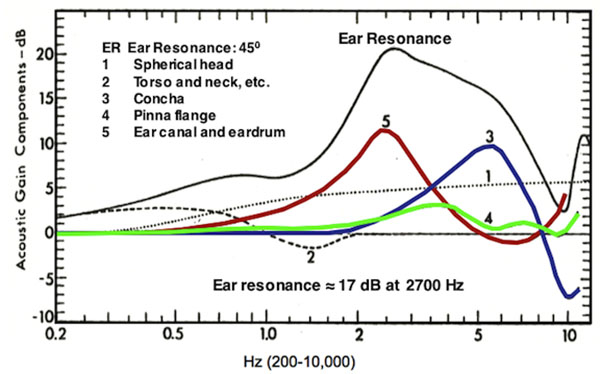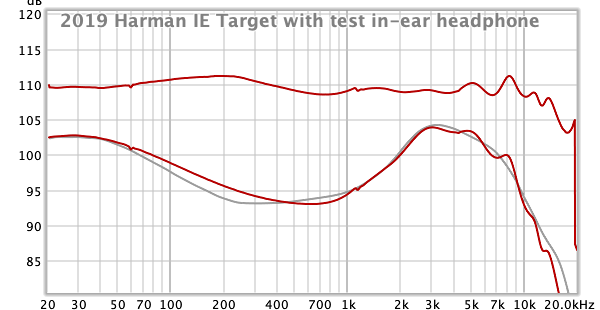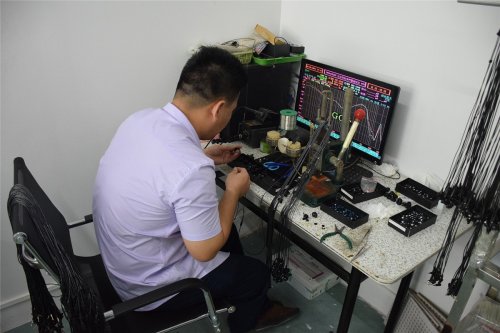JohnYang1997
100+ Head-Fier
There was one document from b&k that showed the peak at 13.5khz is very high at 35+db with real human ears. That's the reason why the highest quality 711 couplers all have that high amplitude peak.
That could be an interesting read. Do you have a link for that? Jude had actually mentioned to us that B&K are working on their own hi-res coupler, based on scans of real ears.There was one document from b&k that showed the peak at 13.5khz is very high at 35+db with real human ears. That's the reason why the highest quality 711 couplers all have that high amplitude peak.
Nice posts @yuriv! Maybe even too nice, because now you'll have intimidated and frightened away potential future contributors to this tourWe've not yet had anybody brave enough to volunteer to measure these headphones with a vinyl tube coupler. It still think it would be interesting to see what the responses look like from a similar-length, flat transfer-impedance cylinder.
Aha! Apple USB-C dongle - got it! Yep, that makes sense. I even have one of those lying around in a drawer somewhere. I should test it with REW...
It looks like we're all in agreement on the hi-res (RA0401/2) coupler. What a shame. After seven pages of this thread, we've had zero arguments. Come on guys, this is headfi! Ok, let me put my GRAS hat on for a minute and play Devil's advocate in defense of the hi-res coupler...
...

I thought that one from b&k was already available. There was a white paper of how they designed and everything. And I think I've seen Sean Olive already measuring in ears with it. I assume it's going to be much better than the gras one. But not so sure.That could be an interesting read. Do you have a link for that? Jude had actually mentioned to us that B&K are working on their own hi-res coupler, based on scans of real ears.
If you were willing to do that for us I'd say go for it! It would be an interesting comparison and I don't think the folks in Europe would mind a delay of a few more days. Many thanks for the offerBut I you really want to see measurements from a vinyl tube coupler, I can do that. The package will be delayed a few more days, though.

Yes it looks really realistic. And I think it's a good start. However it's very concerning that it's designed to be paired with new Hires coupler first of all and more importantly there isn't a transfer characteristic graph any where. Like old coupler, it doesn't need to be the same physical dimensions (or more likely shouldn't be) but acoustic volume to have the preferred impedance. It just needs to be fine tuned for ear entrance point referred acoustic impedance. It shouldn't be very difficult (meaning very possible just needs a lot to do)to do it. So I would love to see measurements done with the BK hires head. Tho I guess it's still only accurate for deep inserting type.If you were willing to do that for us I'd say go for it! It would be an interesting comparison and I don't think the folks in Europe would mind a delay of a few more days. Many thanks for the offer
Thanks to @JohnYang1997 for the link to the B&K paper. I think it might be worth transferring the pm John and I were having over to this thread. John was concerned about the problems with using existing couplers for measuring shallow-insertion IEMs. On that subject, I'd be curious to know if anybody else out there had looked at the GRAS anthropometric pinna? They're allegedly hyper-realistic, with all the typical canal bends and external ear components. Essential for over-ear, probably very helpful for ear-buds and probably somewhat helpful for shallow-insertion IEMs where more of the ear canal is exposed. The downsides (which I guess would apply to any existing or future hi-res couplers too) is 1) cost and 2) it's not a widely-shared standard, i.e., even if it did get closer to the average response of a human ear, it wouldn't be much use for comparing against anybody else's measurements if nobody else in the world has such a device. I guess somebody had to be the first person to blaze the trail(?!). In the meantime, one of the advantages of us all having (roughly) the same coupler is that, having gained a bit of confidence in measuring a couple of common IEMs, we could potentially share future measurements and might actually be able to make meaningful comparisons (at least in terms of deltas) across rigs.
IMO it's always the same story, whatever reference we pick is going to be arbitrary and can only ever be treated as such. I can bet an entire potato that my ears aren't like whatever model of pinna, ear canal, or fancy coupler, and I know I will win because my left ear isn't even like the right one, and my ear canals reach all the way down to Narnia.If you were willing to do that for us I'd say go for it! It would be an interesting comparison and I don't think the folks in Europe would mind a delay of a few more days. Many thanks for the offer
Thanks to @JohnYang1997 for the link to the B&K paper. I think it might be worth transferring the pm John and I were having over to this thread. John was concerned about the problems with using existing couplers for measuring shallow-insertion IEMs. On that subject, I'd be curious to know if anybody else out there had looked at the GRAS anthropometric pinna? They're allegedly hyper-realistic, with all the typical canal bends and external ear components. Essential for over-ear, probably very helpful for ear-buds and probably somewhat helpful for shallow-insertion IEMs where more of the ear canal is exposed. The downsides (which I guess would apply to any existing or future hi-res couplers too) is 1) cost and 2) it's not a widely-shared standard, i.e., even if it did get closer to the average response of a human ear, it wouldn't be much use for comparing against anybody else's measurements if nobody else in the world has such a device. I guess somebody had to be the first person to blaze the trail(?!). In the meantime, one of the advantages of us all having (roughly) the same coupler is that, having gained a bit of confidence in measuring a couple of common IEMs, we could potentially share future measurements and might actually be able to make meaningful comparisons (at least in terms of deltas) across rigs.
The thing gets even worse when the new stuff is actually worse. If done properly the intuition lf interpreting 711 will still can be maintained and it will be even easier to interpret. Because then you can interpret as is instead of throwing off informations and adding guesses. Perhaps for some/many people who only measure/interpret measurements from 711 but not using ears to actually learn through the measurements, it will be harder. The lost bit is that some of the things learned can be wrong. So if this is what you meant. Then I agree.IMO it's always the same story, whatever reference we pick is going to be arbitrary and can only ever be treated as such. I can bet an entire potato that my ears aren't like whatever model of pinna, ear canal, or fancy coupler, and I know I will win because my left ear isn't even like the right one, and my ear canals reach all the way down to Narnia.
for all those tools, my concerns are repeatability, and that they facilitate communication/research. if it's a super fancy super accurate stuff but everybody has a decade of habits interpreting the 711 stuff and does it well, while only 10 places around the world will get the new stuff, then there is a legitimate reason to wonder if it's worth it for everybody to try and adapt to that new stuff as a standard. I'm very glad that such products are being made because better human models will improve music for us in the long run. me being a tiny bit obsessed with ultra accurate HRTF modeling, I certainly welcome those new products. but for us here to look at RAW FR graphs and learn stuff about an IEM, I'm gonna say, who cares? the effective variations from user to user, from one insertion to the next, from even the left side of an IEM to the right, are still going to be there in the end and force us to consider a range of tolerance in our graphs that's often bigger or at frequencies more important than the stuff they work on improving. so... good for them, and one day for us all hopefully. but right now those stuff are like helicopters, really cool, but I don't have one.
 Interesting little setup there. Am I right in thinking you'd need two 711 couplers for this experiment?
Interesting little setup there. Am I right in thinking you'd need two 711 couplers for this experiment? 

I think you're trying to force the objective approach into a preference curve. if we wished for a sound only, perceived at the ears reference, we've had some for a long time and they always ended up somewhere around what etymotic aimed at.Thanks for sharing this @yurivInteresting little setup there. Am I right in thinking you'd need two 711 couplers for this experiment?
I'd worry a bit that having perfectly nulled out those peaks and troughs on your coupler(s), that this would transfer across to your ears. It's a cool idea, but probably overly-optimistic in practice. I suspect it would work best on a headphone that doesn't have too many wild peaks and troughs to begin with.
I've got a few doubts about the Harman target itself and I had some recent communications with Sean Olive about this. Firstly, I should concede this could be an irrelevant rant from somebody who doesn't sit squarely in the middle of the bell curve. The Harman target could still be a correct average. But one thing that's always bothered me is the assumption that it's a fixed curve, even for that "average" individual, because of this:
https://en.wikipedia.org/wiki/Equal-loudness_contour
I asked Sean about this, and here was his reply:
"Yes, it is probably true that at lower levels people might prefer more bass to compensate for reduced sensitivity to bass. Our listening tests were done at normal/comfortable levels (average 80 dB (B-weighted) so it should be more representative of typical playback levels than low levels."
There's no other physical reason for that increase in the low frequencies in the Harman target curve (it's not missing as a result of the ear canals being occluded). Sean didn't mention treble, but I think that's an enigma too, because the same effect ought to apply to the upper frequencies at low volumes, and there's no physical reason that I can see for wanting a roll-off beyond 10 kHz:
...unless, maybe(?) you're trying to mimic sound over large distances (maybe large hall or open-air concert) where you have the usual 1/r^2 decay of all acoustic waves but also faster decay of higher-frequency waves due to viscosity:
https://en.wikipedia.org/wiki/Stokes's_law_of_sound_attenuation
But that would seem to depend on what source you're trying to reproduce, e.g., the large concert venue vs. small studio acoustics. I'd rather that were taken care of in the recording, i.e., place the mics wherever you want and then do your best to faithfully reproduce that. Personally, I'd also like to take a little more off the lower treble of that Harman target curve (it looks like they at least started in that direction in 2019):
If anybody wants the data files for these curves, you can grab them from these links (you can then import them as an FR into REW):
https://www.dropbox.com/s/bnleuzf25m575mu/Harman_target_2018.dat?dl=0
https://www.dropbox.com/s/jr6qjz5v45swlib/Harman_target_2019.dat?dl=0
BTW @yuriv, as always, no pressure here, but did you make any progress with measuring our little set of headphones in that simple vinyl-tube coupler?
Thanks for sharing this @yurivInteresting little setup there. Am I right in thinking you'd need two 711 couplers for this experiment?
I'd worry a bit that having perfectly nulled out those peaks and troughs on your coupler(s), that this would transfer across to your ears. It's a cool idea, but probably overly-optimistic in practice. I suspect it would work best on a headphone that doesn't have too many wild peaks and troughs to begin with.
I've got a few doubts about the Harman target itself and I had some recent communications with Sean Olive about this. Firstly, I should concede this could be an irrelevant rant from somebody who doesn't sit squarely in the middle of the bell curve. The Harman target could still be a correct average. But one thing that's always bothered me is the assumption that it's a fixed curve, even for that "average" individual, because of this:
https://en.wikipedia.org/wiki/Equal-loudness_contour
I asked Sean about this, and here was his reply:
"Yes, it is probably true that at lower levels people might prefer more bass to compensate for reduced sensitivity to bass. Our listening tests were done at normal/comfortable levels (average 80 dB (B-weighted) so it should be more representative of typical playback levels than low levels."
There's no other physical reason for that increase in the low frequencies in the Harman target curve (it's not missing as a result of the ear canals being occluded). Sean didn't mention treble, but I think that's an enigma too, because the same effect ought to apply to the upper frequencies at low volumes, and there's no physical reason that I can see for wanting a roll-off beyond 10 kHz:
...unless, maybe(?) you're trying to mimic sound over large distances (maybe large hall or open-air concert) where you have the usual 1/r^2 decay of all acoustic waves but also faster decay of higher-frequency waves due to viscosity:
https://en.wikipedia.org/wiki/Stokes's_law_of_sound_attenuation
But that would seem to depend on what source you're trying to reproduce, e.g., the large concert venue vs. small studio acoustics. I'd rather that were taken care of in the recording, i.e., place the mics wherever you want and then do your best to faithfully reproduce that. Personally, I'd also like to take a little more off the lower treble of that Harman target curve (it looks like they at least started in that direction in 2019):
If anybody wants the data files for these curves, you can grab them from these links (you can then import them as an FR into REW):
https://www.dropbox.com/s/bnleuzf25m575mu/Harman_target_2018.dat?dl=0
https://www.dropbox.com/s/jr6qjz5v45swlib/Harman_target_2019.dat?dl=0


BTW @yuriv, as always, no pressure here, but did you make any progress with measuring our little set of headphones in that simple vinyl-tube coupler?



Many thanks to @csglinux for the invitation to join this tour! Yes I would like to join this measurement tour. Thanks again!
I'm in Singapore (Asia) so just inform me when the ER2SE happen to land here in Singapore.
I just bought generic 711 coupler complete set with (according to the seller) calibrated microphone from AliExpress during the recent 11-11 sale. The 711 coupler will probably arrive around end of this month.
Just a bit of background, I've been experimenting IEM measurement since 2015 using MiniDSP UMIK-1 and Superlux ECM888B microphone, with DIY heat shrink tube coupler. I tried different volume and length, and now have been using 7mm diameter - 14mm length coupler as shown in the picture. Once I got the 711 coupler I will make some comparisons and probably build more heat shrink coupler that could match the 711 coupler (hopefully).
Result of measurement from different coupler length from 0mm up to 35mm in 2.5mm step:


